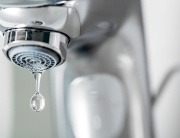Backflow means the undesirable reversal of flow of a liquid, gas, or suspended solid into the potable water supply; a backflow preventer is designed to keep this from happening. Points at which a potable water system connects with a non-potable water system are called cross connections. Such connections occur naturally in appliances such as clothes washers and dishwashers, but they must be carefully designed and installed to prevent backflow. Another common location for a backflow preventer is the connection of a fire sprinkler system to a water main, to prevent pressurized water from flowing from the fire suppression system into the public water supply.
Back-siphonage occurs when higher pressure fluids, gases, or suspended solids move to an area of lower pressure fluids. For example, when a drinking straw is used to consume a beverage, suction reduces the pressure of fluid inside the straw, causing liquid to move from the cup to inside the straw and then into the drinker’s mouth. This is an example of an indirect cross-connection, undesirable material being pulled into the system.
Back-pressure occurs for example when air is blown through the straw and bubbles begin to erupt at the submerged end. If instead of air, natural gas had been forced into a potable water tank, the gas in turn could be carried to a kitchen faucet. This is an example of a direct cross-connection, with undesirable material being pushed into the system.
Back pressure can force an undesirable contaminant to enter potable water piping. Sources of back pressure may be boilers, heat exchanging equipment, power washing equipment, fire sprinklers, or pumps in the water distribution system. In some cases there may be an almost continuous risk of overcoming the static water pressure in the piping. To reduce the risk of contamination, a backflow preventer can be fitted. A backflow preventer is also important when potentially toxic chemicals are used, for instance for commercial/industrial descaling of boilers, or when chemical bleaches are used for residential power washing.
A closely related device is the backwater valve, which is designed to prevent sewage from backing up into a building and causing basement flooding.
Backflow Prevention Testing
Our staff is certified to test your plumbing for backflow prevention. To maintain clean drinking water, backflow prevention is a must! We can check your system for any problems and give you an assessment on what you can do to prevent contamination from occurring. Call us for a professional evaluation or to schedule a test on your system.












Leave A Comment